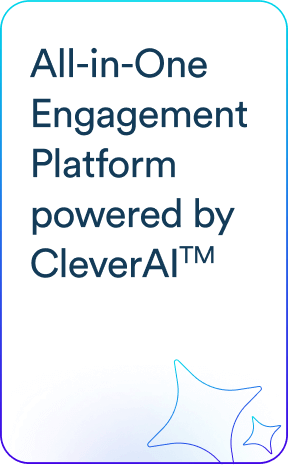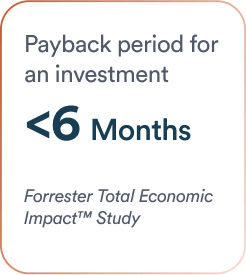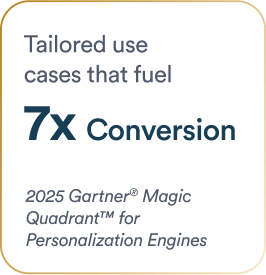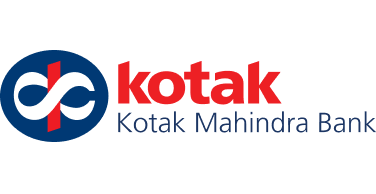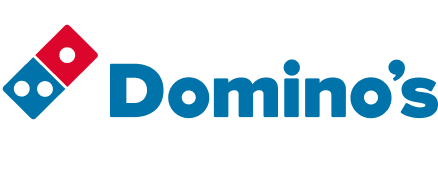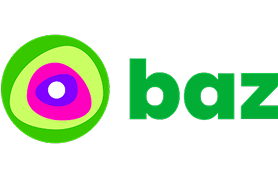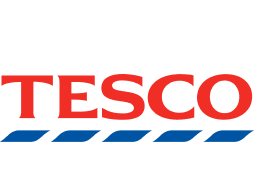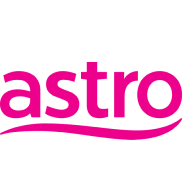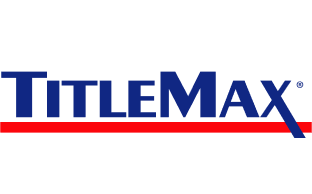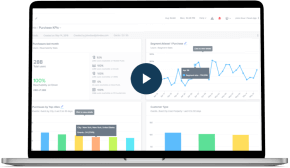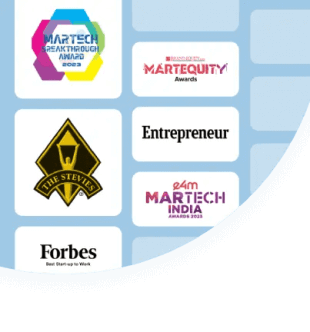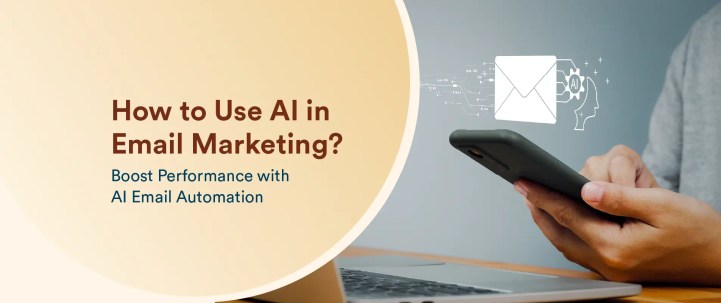AI enhances email marketing with personalization, automation, and data-driven insights. This guide covers its benefits, key strategies, and use cases to improve engagement and boost conversions.
What is AI-Powered Email Marketing?
AI-powered email marketing refers to the application of Artificial Intelligence technologies—such as machine learning, natural language processing (NLP), and predictive analytics—to plan, create, and manage email campaigns. Rather than relying on guesswork or generic content, AI empowers marketers with data-driven insights to tailor messages, timing, and frequency for each unique subscriber.

Numerous industries already leverage AI to a great effect in their email marketing campaigns, these include:
- Retail and E-Commerce: For personalized product recommendations and triggered abandoned-cart emails
- Finance: For transaction alerts, fraud notifications, and tailored investment suggestions
- Healthcare: For appointment reminders and targeted wellness guidance
- Hospitality: For curated travel recommendations, loyalty program updates, and booking confirmations
- Gaming: For personalized win-back email campaigns, in-game event announcements, and targeted new content promotions
- Streaming and Media: For tailored onboarding emails, curated content updates, and user-specific recommendations
How to Use AI in Email Marketing
Below are practical, in-depth strategies to seamlessly integrate AI into your email marketing program.

1. AI for Email Segmentation
Email segmentation is crucial for targeting the right audience with relevant messaging. While traditional customer segmentation often groups subscribers based on rudimentary data (e.g., location, age), AI refines this approach by analyzing numerous data points.
- Behavioral Segmentation: AI helps with behavioral segmentation by tracking on-site behavior, email engagement, purchase frequency, and average order value. It then clusters customers who share similar characteristics.
- Recency, Frequency, Monetary Analysis (RFM): AI conducts recency, frequency, and monetary (RFM) analysis by evaluating how recently and frequently a customer has interacted or purchased, as well as their average spend. This segmentation enables highly targeted campaigns based on a customer’s overall value and activity.
- Value-Based Segmentation: AI determines which customers yield the highest lifetime value, allowing marketers to create tiered email strategies that reflect different levels of spending and loyalty.
- Dynamic Updates: AI algorithms update segments in real time. As soon as a subscriber takes a new action (e.g., clicking a specific link, or downloading a guide), they can be moved to a more appropriate segment.
- Location-Based Segmentation: AI factors in geographical data to craft campaigns around local events, seasonal changes, or region-specific deals.
2. Personalized Content and Recommendations
AI excels at delivering hyper-personalized product recommendations and content suggestions:
- Smart Product Feeds: In e-commerce, AI can generate product feeds within emails that reflect an individual’s browsing and purchase history. This approach can significantly boost conversions and click-through rates.
- Customized Messaging: Instead of addressing everyone with the same copy, AI tailors not only the product offering but also the tone, images, and product descriptions to each recipient.
- Sentiment Analysis: Some AI systems integrate NLP for sentiment analysis, allowing you to fine-tune the emotional tone of messages to resonate better with different audience segments.
- Automated Product Bundling: AI can analyze purchase patterns to group complementary items or frequently bought-together products into bundles. Presenting these bundles in emails encourages higher-order values and cross-sell opportunities.
3. Predictive Analytics for Timing and Frequency
One of the most common challenges in email marketing is determining when and how often to send emails. AI addresses this by:
- Optimal Send Times: Analyzing past engagement patterns to identify times when subscribers are most active, ensuring your emails are top-of-inbox when they check.
- Frequency Regulation: AI can detect early signs of subscriber fatigue and automatically adjust sending frequency to reduce unsubscribes.
- Seasonality Insights: AI picks up on seasonal or cyclical behavior, helping you time promotional campaigns and announcements more effectively.
4. Automated Campaign Management
AI-Powered Email Automation goes beyond simple drip campaigns:
- Trigger-Based Workflows: If a subscriber joins your mailing list, visits your pricing page, or abandons a cart, AI triggers relevant emails at precisely the right moment.
- Lifecycle Nurturing: AI-drive email campaigns adapt to where a subscriber is in their journey, offering the content they need to move forward (e.g., from awareness to consideration to purchase).
- Content Creation Assistance: Some AI-powered email marketing tools provide automated subject line or body copy suggestions based on successful patterns, speeding up the content creation cycle.
5. A/B Testing
AI elevates traditional A/B testing to a higher level of sophistication:
- Rapid Iterations: AI can quickly evaluate multiple variations of subject lines, copy, or designs of emails and identify the winning elements in real time.
- Data-Driven Insights: Algorithms weigh email performance metrics across audience segments, revealing deeper insights into why a certain variation works.
- Continuous Optimization: AI-powered email marketing tools don’t stop once the test concludes; they continuously refine the email elements even after the campaign goes live.
6. Other Applications
- Email Retargeting: For users who explored a specific product but did not convert, AI can segment them into retargeting sequences with relevant incentives.
- Language and Tone Analysis: AI ensures your brand’s tone is consistent across campaigns while also adapting language to appeal to various demographics.
- Customer Journey Mapping: AI-powered email automation tools can map out each phase of a customer’s interaction with your brand, helping build out customer lifecycle email campaigns. They can suggest precisely timed emails that guide them from awareness to retention.
Benefits of Email Automation & Use of Artificial Intelligence
Implementing AI-powered email marketing solutions can yield significant advantages for both marketers and recipients alike. Here are some key benefits you can anticipate when integrating AI into your email marketing strategy:
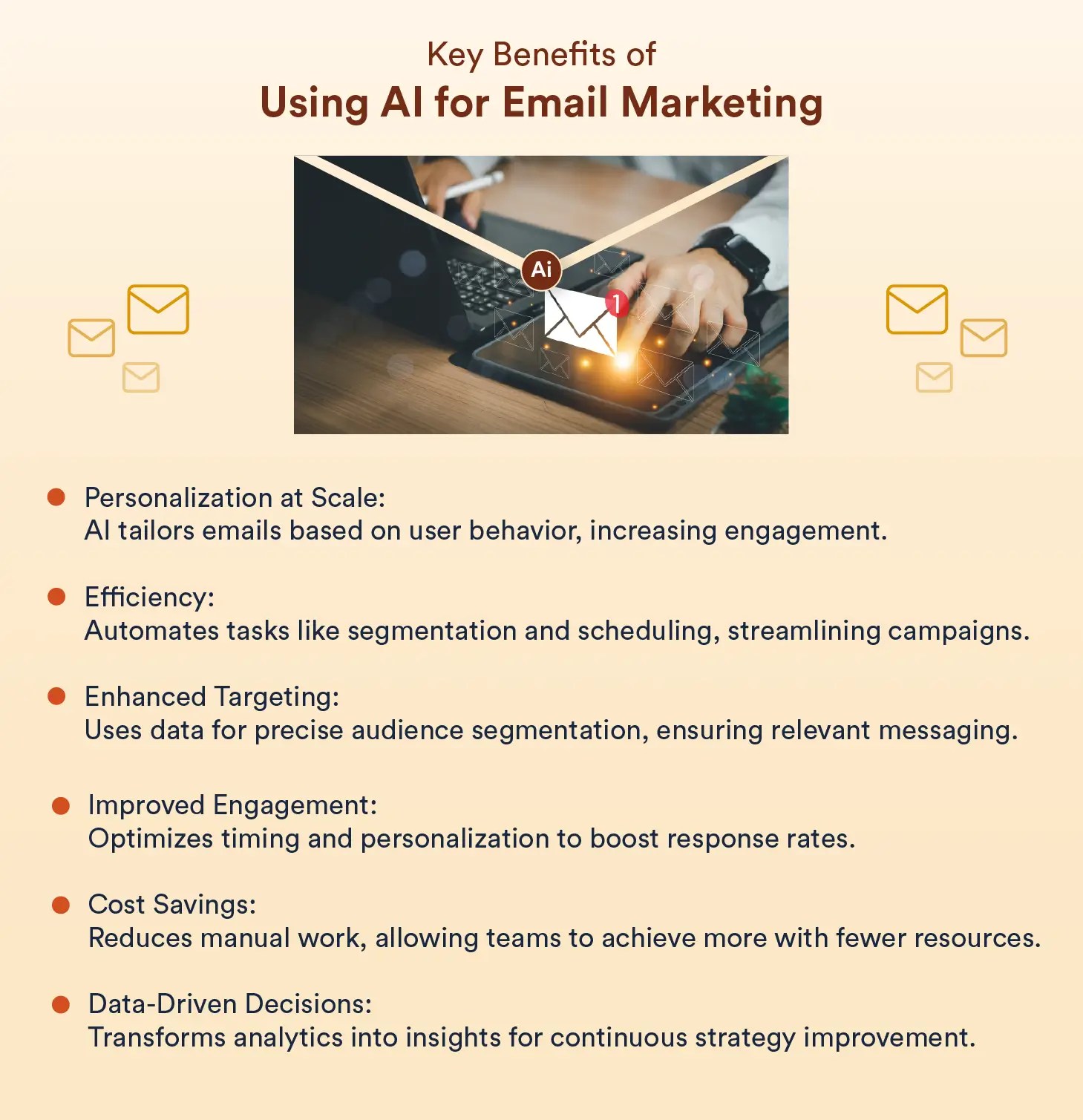
Personalization at Scale
Advanced algorithms sift through large volumes of customer data to deliver highly tailored content. Rather than generalized email newsletters, each subscriber receives messages speaking directly to their needs and interests. This approach fosters deeper customer engagement by aligning emails with user behaviors or browsing patterns.
Efficiency
AI-powered email automation saves time by handling repetitive tasks such as segmentation, scheduling, and performance analysis. This allows marketers to focus on strategy. Over time, this can help accelerate campaign turnarounds and ensure more consistent messaging. With email automation workflows set up, it also becomes easy to send triggered campaigns powered by AI.
Enhanced Targeting
AI enables precise audience segmentation based on past behavior, purchase histories, demographics, and real-time interactions. This translates into more relevant email campaigns and helps avoid irrelevant messaging, as a result improving subscriber trust and satisfaction.
Improved Engagement
The use of AI in email marketing increases the likelihood of customer engagement as it can determine the optimal time to send emails and personalize subject lines. It aligns send times with different time zones and user habits to further boost audience response.
Cost Savings
Automating repetitive tasks can reduce effort and resources for manual processes, directing budgets and manpower to other critical areas. This way, marketers can focus on strategy and creativity. AI can lower overhead costs and enable smaller teams to accomplish more with fewer resources.
Data-Driven Decisions
AI in email automation provides actionable insights through analytics and enables smarter marketing decisions. It can translate raw performance data into actionable metrics, that organizations can use to continually refine their email strategies for sustained growth.
How Clever.AI Can Be Your AI Email Marketing Companion
Clever.AI is an advanced, AI-driven platform by CleverTap that can effectively simplify and enhance email marketing workflows. By combining real-time data analytics, intelligent segmentation, and automated content optimization, Clever.AI helps businesses of all sizes to create deeply personalized, high-impact campaigns. The platform’s features address various stages of the email marketing lifecycle, including:
- Smart Segmentation: Leverages AI algorithms to group subscribers based on past behavior, preferences, or engagement levels.
- Predictive Timing: Uses historical and contextual data to determine the best moment to send emails for maximum open and click-through rates.
- Automated Personalization: Dynamically inserts product recommendations and tailored content into each email, creating a customized experience for every subscriber.
- Performance Insights: Provides real-time analytics that measures campaign effectiveness, offering data-driven suggestions for improvement.
With Clever.AI, email marketers can maintain a balance between machine-driven efficiency and authentic brand storytelling. This ensures campaigns resonate with subscribers while still achieving measurable email marketing ROI and growth.
Explore Clever.AI’s game-changing capabilities. Learn how to boost your email campaigns with Clever.AI.
Tips on How to Boost Performance with AI in Email Marketing
There are specific email marketing best practices to keep in mind when incorporating AI in the mix. Let’s have a look.
Start with Clear Objectives
Define specific goals, whether that means boosting email click-through rates, improving conversions, or building long-term customer loyalty. Having clearly established objectives helps in selecting the right AI tools and metrics to focus on.
- Example: If the goal is to reduce cart abandonment, use AI triggers to send personalized follow-up emails within an hour of cart abandonment.
- Best Practice: Keep objectives measurable. Use indicators like open rates, click-through rates, and conversions to gauge success.
Invest in Quality Data
AI is only as strong as the data it processes. Ensure data sources are accurate, thorough, and well-organized. This includes regularly cleaning up your email lists to remove invalid addresses and duplicates.
- Example: Segment or flag dormant subscribers, then feed this updated information back into AI models to refine targeting.
- Best Practice: Employ data management platforms to centralize subscriber data and integrate behavioral analytics.
Learn the core tenets of data-driven email marketing and the strategies to implement.
Test Regularly
Implement one AI-driven feature at a time, then measure its direct impact on key performance metrics. This approach isolates each feature’s effect and highlights which AI enhancements are most beneficial.
- Example: Launch AI-driven subject line optimization first, track improvements in open rates, and then introduce AI-driven send-time optimization.
- Best Practice: Use control groups that don’t receive AI enhancements to compare performance effectively.
Maintain a Human Touch
While AI can automate, personalize, and optimize, maintaining an authentic connection with subscribers remains crucial. Balance the efficiency of AI with messages that showcase a genuine brand voice and empathy.
- Example: Add a personal note from a customer success manager or brand ambassador within an otherwise AI-driven campaign.
- Best Practice: Regularly evaluate AI-generated content for tone and clarity, ensuring it aligns with brand identity and values.
Stay Compliant
Regulations like GDPR and CAN-SPAM require strict data handling and opt-in management. Keep up to date with legal frameworks and industry guidelines.
- Example: If collecting personal data for AI-driven personalization, clearly disclose how it will be used and gain explicit consent.
- Best Practice: Maintain an easily accessible unsubscribe link and promptly honor opt-out requests to preserve subscriber trust.
Challenges and Limitations of Using AI for Email Marketing
Although AI offers numerous benefits, marketers should be aware of key challenges and potential pitfalls. Addressing these issues proactively can help maintain efficient, compliant, and customer-centric email strategies:
- Data Privacy Concerns: Compliance with regulations (e.g., GDPR, CCPA) requires transparent data collection and usage. Balancing personalization with privacy can be complex.
- Initial Investment: Quality AI tools and skilled personnel can be expensive. Smaller businesses must evaluate how quickly these costs can be recouped.
- Technical Complexity: The learning curve for AI software may necessitate training or hiring specialized talent.
- Risk of Over-Automation: Too much automation can result in a robotic feel, eroding the human connection with subscribers.
- Data Dependencies: AI outcomes are highly dependent on the volume and accuracy of your data. Any data gaps or inaccuracies can skew the results.
Metrics and Performance Tracking
Measuring success is essential to refining your AI-driven email marketing strategy. Some key email marketing metrics include:
- Email Open Rates: These gauge the effectiveness of subject lines and brand credibility.
- Click-Through Rates (CTR): They reveal how engaging and relevant your email content is.
- Conversion Rates: Email marketing conversion rates demonstrate the degree to which subscribers follow through on your desired action (e.g., purchases, sign-ups).
- Bounce Rates: These identify data quality issues or invalid email addresses.
- Unsubscribe Rates: Offer insight into subscriber satisfaction and help detect over-sending or irrelevant messages.
Use Cases & Real-World Examples of AI-Powered Email Marketing Automation
Below are some real-world examples of how different industries use AI to deliver more personalized email campaigns:
Retail Industry
Targeted upsell campaigns are triggered when a customer purchases related products or accessories. For example, large retailers like Walmart harness AI to suggest complementary products via follow-up emails, boosting cross-sell opportunities.*
E-commerce Businesses
Automated abandoned cart sequences combine dynamic discounts, product recommendations, and urgency. Amazon, for instance, leverages AI-powered reminders with personalized deals and relevant items, enticing shoppers to complete their purchases.*
Learn more about strategies to incorporate in email marketing for e-commerce.
Healthcare
Appointment reminders, wellness tips, and medication adherence prompts are tailored to individual patient profiles. Telemedicine platforms like Teladoc employ AI-driven email messaging to encourage consistent health check-ins and on-schedule appointments.*
Hospitality Industry
Seasonal travel promotions, customer loyalty program updates, and curated itinerary suggestions are delivered based on previous bookings. Marriott, for example, uses AI to analyze member preferences and send exclusive offers and relevant recommendations for future trips.*
Future of AI in Email Marketing
AI’s role in email marketing will continue to grow, driving hyper-personalization, advanced NLP, automated template design, and real-time adaptation. As these innovations mature, businesses can create entire email journeys while instantly responding to subscriber context. This evolution yields higher engagement, increased conversions, and more meaningful customer connections.
By effectively integrating AI in email marketing, your brand can shift from generic blasts to thoughtful, deeply relevant emails that resonate with subscribers.
CleverTap email marketing platform is a comprehensive marketing and analytics platform that harnesses advanced AI, segmentation, and automation to supercharge email campaigns. By analyzing user behavior in real time, CleverTap enables businesses to deliver highly relevant messages, boosting engagement and retention. Try CleverTap to discover how it can transform your email marketing strategy and grow your business. Book a demo now!
Shivkumar M 
Head Product Launches, Adoption, & Evangelism.Expert in cross channel marketing strategies & platforms.
Free Customer Engagement Guides
Join our newsletter for actionable tips and proven strategies to grow your business and engage your customers.

